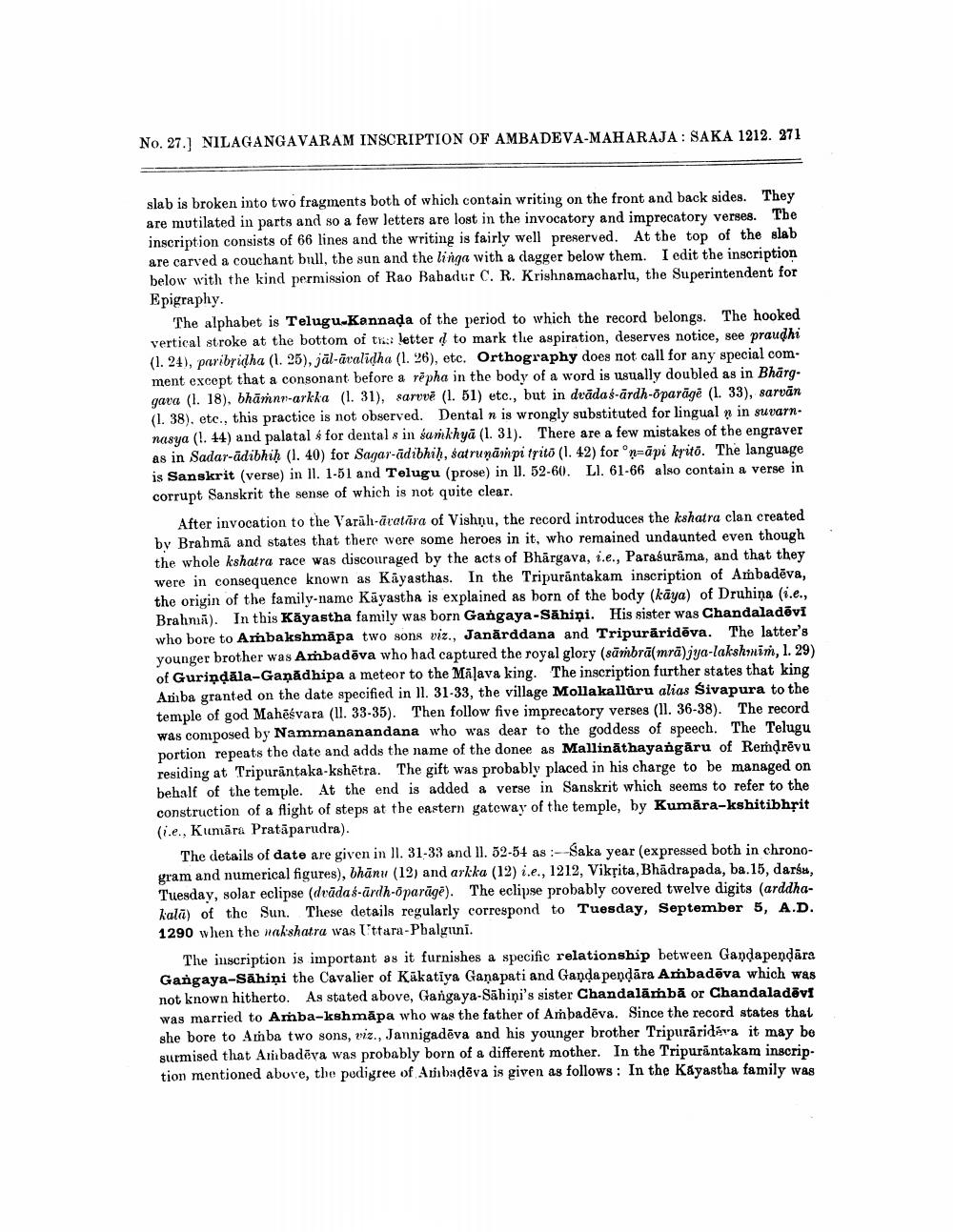________________
No. 27.] NILAGANGAVARAM INSCRIPTION OF AMBADEVA-MAHARAJA: SAKA 1212. 271
slab is broken into two fragments both of which contain writing on the front and back sides. They are mutilated in parts and so a few letters are lost in the invocatory and imprecatory verses. The inscription consists of 66 lines and the writing is fairly well preserved. At the top of the slab are carved a couchant bull, the sun and the linga with a dagger below them. I edit the inscription below with the kind permission of Rao Bahadur C. R. Krishnamacharlu, the Superintendent for Epigraphy.
The alphabet is Telugu Kannada of the period to which the record belongs. The hooked vertical stroke at the bottom of tu letter d to mark the aspiration, deserves notice, see praudhi (1. 24), paribridha (I. 25), jāl-āralidha (1. 26), etc. Orthography does not call for any special com. ment except that a consonant before a rēpha in the body of a word is usually doubled as in Bhārg. gava (1. 18), bhāṁnn-arkka (1. 31), sarvvé (1. 51) etc., but in dvāda s-ardh-Oparāge (1. 33), sarvān (1. 38), etc., this practice is not observed. Dental n is wrongly substituted for lingual » in suvarn. nasya (!. 44) and palatal é for dentals in sankhyā (1. 31). There are a few mistakes of the engraver as in Sadar-adibhiḥ (1. 40) for Sagar-ūdibhih, satrunāın pi trito (1.42) for on-āpi krito. The language is Sanskrit (verse) in 11. 1-51 and Telugu (prose) in 11. 52-60. LI. 61-66 also contain a verse in corrupt Sanskrit the sense of which is not quite clear.
After invocation to the Varah-avatāra of Vishnu, the record introduces the kshatra clan created by Brahma and states that there were some heroes in it, who remained undaunted even though the whole kshatra race was discouraged by the acts of Bhargava, i.e., Parasurama, and that they were in consequence known as Kāyasthas. In the Tripurāntakam inscription of Ambadēva, the origin of the family-namo Kayastha is explained as born of the body (kaya) of Druhiņa (i.e., Brahma). In this Kayastha family was born Gangaya-Sāhiņi. His sister was Chandaladāvi who bore to Ambakshmāpa two sons viz., Janārddana and Tripurăridēva. The latter's younger brother was Ambadēva who had captured the royal glory (sāmbrā( mrā)jya-lakshmi, 1. 29) of Gurindāla-Ganadhipa a meteor to the Malava king. The inscription further states that king Auiba granted on the date specified in 11. 31-33, the village Molla kalluru alias Sivapura to the temple of god Mahēśvara (11. 33-35). Then follow five imprecatory verses (11. 36-38). The record was composed by Nammananandana who was dear to the goddess of speech. The Telugu portion repeats the date and adds the name of the donee as Mallināthayangāru of Remdrēvu residing at Tripurantaka-kshētra. The gift was probably placed in his charge to be managed on behalf of the temple. At the end is added a verse in Sanskrit which seems to refer to the construction of a flight of steps at the eastern gateway of the temple, by Kumāra-kshitibhrit (ie., Kumāra Pratāparudra).
The details of date are given in II. 31-33 and 11. 52-54 as :- Saka year (expressed both in chronogram and numerical figures), bhānu (12) and arkka (12) i.e., 1212, Vikrita, Bhadrapada, ba.15, darsa, Tuesday, solar eclipse (drūdas-Īrilh-öparāgë). The eclipse probably covered twelve digits (arddhakalā) of the Sun. These details regularly correspond to Tuesday, September 5, A.D. 1290 when the nakshatra was Uttara-Pbalguni.
The inscription is important as it furnishes a specific relationship between Gandapendāra Gangaya-Sähiņi the Cavalier of Kākatiya Ganapati and Ganda pendāra Ambadēva which was not known hitherto. As stated above, Ganga ya-Sāhini's sister Chandalāmbā or Chandaladēvi was married to Amba-kshmäpa who was the father of Ambadēva. Since the record states that she bore to Amba two sons, viz., Jannigadēva and his younger brother Tripurăridáva it may be surmised that Aribadeva was probably born of a different mother. In the Tripurantakam inscription mentioned above, the pedigree of Aribadēva is given as follows: In the Kayastha family was




